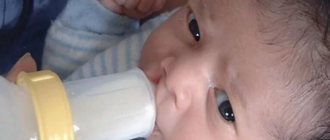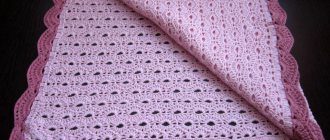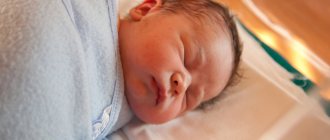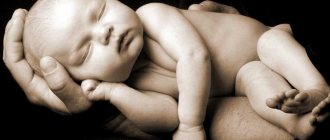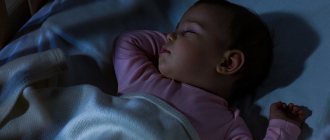During the first few months of life, sleep takes up most of the baby's life. During this period, about twenty hours, or even more, are allotted for dreams. Adequate sleep is extremely important for the baby’s body, because at this time it grows and develops, gains strength, and the baby’s brain processes all the information received during the day.
Young parents think about what conditions need to be created for a full and comfortable sleep for their baby. In addition, new mothers and fathers are concerned about what position is best and safest for the child to stay in the “land of dreams,” and what body positions should be avoided.
Conditions for good sleep
The baby usually chooses his own sleeping position. But the creation of all the necessary conditions and a favorable environment falls entirely on the shoulders of the parents. That is why mom and dad must clearly know and understand what needs to be done so that the baby sleeps soundly, does not worry and is not capricious:
- The air temperature in the room in which the baby sleeps should fluctuate around 20-22 degrees. Otherwise, the baby's sleep will be restless. The temperature should not be lower than 18 degrees. Increased air temperature in the room, excessive dryness, combined with the slightest runny nose in a child will lead to the formation of crusts in his nose.
- Before going to bed, be sure to ventilate the room. During the warm season, it is recommended to leave the window open.
- The optimal room humidity should be 60%. The maximum permissible humidity level is 75%. To maintain the required indicator, it is recommended to regularly carry out wet cleaning and ventilate the room.
- The mattress should be moderately hard and in no case sag under the weight of the baby.
It is recommended to close the curtains in the room while the baby sleeps to prevent sunlight from entering the baby's eyes. Sunlight should not be harsh.
How does your baby sleep?
These elaborate poses... It's hard for an adult to imagine how this could be comfortable even while awake... Apparently, cribs are a great place for funny photo shoots. Every mother has a story on the topic of sleep, and they know exactly which position is the most preferable for a child to rest.
First, let's pay attention to how the child falls asleep. The position before bed is a direct illustration of how the baby relates to the past. Does he do this with his back turned? Most likely, he is offended by something and is sulking at the whole world. Will he easily go into sleep mode if petted? This means he really needs affection and physical contact.
Some sleeping positions are classified as follows:
1. Frog. You can come across the opinion that if a baby likes to sleep on his stomach with his legs tucked in, then he seems to be protesting against the very fact of sleep and does not want to waste time on it. Cribs for newborn rebels should have a flat base, without any pillows or heavy blankets. Then the sleep of the “protesters” will be safe.
2. Star. Confident in the safety of the whole world and open-minded people sleep in the “arms and legs in different directions” position. They are in full view. Make sure that the outstretched arms do not get stuck in the bars of the crib. It is better to buy a crib with a removable wall.
3. The soldier pose is most often chosen as the main one by not very emotional children. Straight body, arms at your sides - you can’t get out an extra word. But there's nothing wrong with that. On the contrary, the straighter the body is during sleep, the fewer internal unresolved problems the child has. And everything else is temperament.
Twisted postures - curled up, or in a hole under a blanket with your head up - are considered alarming signals. Cribs with a lot of textiles in such cases may be unsafe. Pay attention to your child, perhaps he is lonely, he is afraid of something, or he feels danger at some points during the day.
4. The fetal position is very physiological, but it can also demonstrate that the child needs your affection and protection more than usual.
5. Balanced children, sanguine in temperament, cheerful and easy-going, sleep on their tummy with their legs bent They quickly outgrow the cribs for newborns and pretend to be furniture for preschoolers - stylized as cars or a princess bed.
No matter how your child sleeps, do not shift him, guided by the logic “it’s more convenient.” It’s better to listen to him during the day, then at night he will open up in every sense towards complete rest.
If your baby sleeps restlessly
It happens that the baby sleeps very restlessly and lightly. Parents are concerned about what could cause this phenomenon and how to correct the situation. If the baby does not sleep well and wakes up frequently, it is likely that the temperature regime differs from the optimal values.
The cause of restless sleep may be an incorrect level of humidity in the room in which a small child sleeps. In addition, this phenomenon is often caused by problems with the baby’s digestion, excessive bloating, and colic. This problem is especially relevant for children from 0 to 3 months. As a rule, after reaching the age of three months, the baby’s digestion normalizes, and with it sleep.
In any case, new mothers and fathers need to study their child, his character traits, in order to be able to guess the causes of restless behavior and be able to eliminate them in a timely manner.
Acceptable positions for a newborn during sleep
Older children, from about 4 months, choose their own sleeping position. But newborns are in the “land of dreams” in the position that their parents chose for them.
The natural body position for a baby is the frog pose, in which the small child lies on his back, with his arms slightly bent at the elbows, legs at the knees, and his head turned to the side. In addition, the baby can be placed on his tummy or on his side. We need to say a few words about the benefits of different baby body positions in order to choose the optimal sleeping position for a newborn.
On the side
The lateral position is considered the safest and most optimal for a newborn. Many experts consider this to be the best sleeping position for a newborn. However, the possibility of the baby turning onto his stomach should be excluded. To do this, gently place a special orthopedic cushion or a regular towel rolled into a sausage under the back of a small child.
The main advantage of this position for sleeping a newborn, the photo of which is presented above, is that the baby, lying on his side, presses his legs to his tummy, which ensures the safe passage of gases and improved digestion.
Parents should understand that lying on the side increases the load on the baby’s pelvic bones. It is strictly prohibited for newborns and babies up to three months inclusive with hip dysplasia to sleep in this position.
In addition, the baby's arms are free on the side. This is why a baby can easily scratch himself. To avoid such consequences, it is enough to wear a vest with sleeves or use sleeves separately. You can purchase a special wardrobe item at almost any children's goods store.
Correct position
The correct position of the newborn during sleep is of great importance when laying down. First of all, you need to prepare the crib. The mattress should be smooth, dense, without dips. The baby pillow is not used. The baby's head should be at body level.
Now let's look at the possible sleeping positions for a baby.
Sideways position
Doctors advise putting a newborn to sleep sideways after discharge from the maternity hospital. This position is considered optimal because the baby is placed to rest immediately after eating. Babies often burp, and lying sideways will not suffocate.
In a half-side position
In this form, it is necessary to properly put the newborn to sleep in the crib if colic and frequent regurgitation are bothering you. This way the baby won’t burp, and the gases will go away unnoticed.
Children may toss and turn while resting. To prevent rolling over, you need to place a rolled blanket under the baby’s back. Many children scratch, so they can wear special protective gloves (scratch gloves).
If your baby sleeps sideways or half sideways at night, he needs to be periodically turned over to the opposite side. In this way, it will be possible to avoid problems such as torticollis.
On the back
You can put your baby to sleep on his back. But this situation carries with it some danger. On the one hand, resting on your back is useful because the spine is in a natural position. The danger is that the baby may burp after feeding and suffocate in its own regurgitation.
To properly place your newborn to sleep on his back, you must follow the following rules:
- Although the baby lies with his face up, his head needs to be turned to the side, securing this position with a roller. You can use a diaper as a bolster;
- If the baby sleeps on his back for a long time, then you need to move his head to the other side so that the neck does not bend.
There is a contraindication for this position in sleep. This is a pathology of the hip joints (congenital dysplasia). There is no need to place your baby on his back if he is often bothered by colic.
On the tummy
If you put a newborn baby to sleep on his tummy, this position will serve as a preventive measure for better passage of gas and problems with digestion of food. Lying in this position, the baby will not choke if she burps.
Putting a baby to sleep on his tummy is correct. This is explained by the fact that in this position the baby’s muscle tissue is strengthened. The neck and back muscles become stronger.
There are some rules to follow when placing your baby on his tummy:
- choose a hard mattress (preferably orthopedic);
- no pillow needed;
- There is no need to put oilcloth sheets under your laundry. A well-chosen diaper is enough for your baby;
- Do not place toys in the crib, it is better to hang them up.
While sleeping on your tummy, you need to periodically approach your baby and check if he is comfortable.
Like an embryo
Some babies, even closer to 2 months, continue to sleep with their legs pulled up to their tummy. This position can cause muscle tissue overstrain. If after a month or 6 weeks the baby straightens up, then there is no need to worry.
On the stomach
This position of the baby’s body has a number of undeniable advantages.
The tummy sleeping position for a newborn is recommended for babies who suffer from frequent regurgitation. Because in this position there is no chance of choking. In addition, experts recommend choosing the stomach position for those babies who have digestive problems, colic, and problematic passage of gases. In addition, finding the baby’s body in this way helps strengthen and overall develop the baby’s muscular system.
However, this sleeping position for a newborn baby also has its disadvantages. It is strictly not recommended to leave a baby on his tummy without adult supervision for a long time. Because in this position there is a risk of sudden cessation of breathing as a result of covering the baby’s nose with a pillow or blanket. Infants older than one week and younger than one year are generally at risk.
The dangers of incorrect sleeping positions for babies
A child who does not get proper rest is always more capricious and irritable than a well-rested baby. An incorrect sleeping position for a baby can not only lead to restless sleep, but also cause significant harm to the health of the newborn.
Some poses are contraindicated for medical reasons. For example, if you have dysplasia, it is not recommended to put your baby to sleep on his side; this will not contribute to the proper development of the bones and ligaments of the hip joint.
If there is muscle hypertonicity, it is not recommended to place the child on his tummy, because with active movements during sleep he will constantly wake himself up and he will not get a good rest. Previously, the problem of excessive activity was solved by using tight swaddling. But recently, pediatricians and orthopedists are increasingly recommending abandoning this practice for a more systematic and natural development of the musculoskeletal system. However, with increased gas formation and colic, sleeping on the stomach or side will help the child’s body get rid of gas.
An incorrectly chosen sleeping position for a baby can even lead to such a sad consequence as death in a dream. That is why it is highly not recommended to leave the baby in the tummy position without constant supervision.
Sudden infant death syndrome (SIDS)
Unexplained death in a dream, or as it is also called “death in the cradle,” is a real grief and tragedy for the parents of a child. Sudden infant death syndrome (SIDS) includes all cases when a baby dies of unknown etiology.
Often, when conducting a post-mortem examination of a baby, doctors establish signs of hypoxia - oxygen starvation of the body. Factors that accompany the occurrence of SIDS include:
- Sleeping in the “stomach” position. The influence of this position is beyond doubt among doctors. Official statistics of experiments on changing the sleeping position of babies showed a decrease in the number of infant deaths by 2-3 times. The studies were conducted in Germany and the USA from 1992 to 1994.
- Wrapping yourself up too tightly, wearing clothes that are too warm. This overheats the baby and creates oxygen starvation of the tissues. In some countries, pediatricians now suggest using a baby night bag with a specified heat resistance instead of a blanket. This prevents the baby from suffocating in the folds of a crumpled blanket and allows you to maintain the temperature regime of a newborn's rest.
- Bed too soft. We have already mentioned that the sleeping surface should be flat, without folds, and the mattress should be orthopedic, with a tightly stretched mattress pad.
- Mother's illnesses during pregnancy. Mandatory observation by a doctor is recommended if the mother suffered any illnesses during pregnancy.
- Irresponsible attitude of a pregnant mother towards issues of smoking, alcohol abuse or drug use.
Torticollis
An incorrect sleeping position can lead to such an unpleasant illness as torticollis. In an infant, it can develop after being in one position for a long time, or as a result of an incorrectly selected bed. This is a serious disease that can even lead to disability for the baby.
Orthopedists recommend changing the position of the baby's head more often. For example, if a child sleeps on his back, you need to shift the head alternately: to the left and then to the right side. This will eliminate the possibility of congestion in the muscles and eliminate the risk of developing torticollis. It is also not recommended to use pillows for children under six months of age. This can prevent the bones and muscles of the neck from forming properly.
On the back
The sleeping position for a newborn on his back is the most common and safest. With this position of the baby’s body, the head is turned on its side, and the risk of choking as a result of regurgitation is minimized.
Parents strictly need to alternate the sides in which the baby’s head is turned while in a horizontal position. This is necessary in order to prevent the risk of the occurrence and further development of problems with the baby’s musculoskeletal system, including torticollis, a fairly common disease that occurs in young children under the age of one year.
This sleeping position is not suitable for babies with hip dysplasia. For them, the most acceptable position is on the tummy. In addition, experts strongly recommend that parents of babies who suffer from digestive problems and have difficulty passing gases avoid sleeping on their tummy. The latter situation can be resolved with the help of a heating pad or a warm diaper.
Possible sleeping positions for babies
It is important not only to properly organize the conditions for comfortable sleep, but also to know how to properly sleep for a newborn in a crib. Pediatricians agree that correct posture is the key to healthy sleep. Let's look at popular poses separately:
- Sleeping on your back
. According to experts, it is safest for a child to sleep on his back. There are many advantages to the fact that the baby sleeps in this position. Firstly, this reduces the risk of regurgitated material getting into the respiratory tract. In the first days after birth, the baby cannot hold his head straight; it still turns on its side, and in case of regurgitation, the oral cavity is released naturally. When the child gets a little older, you already monitor the position of his head - carefully turn it to the side. - Sleeping on your side
. Many people believe that it is safest for a newborn baby to sleep on his side in a crib. Due to the nature of this sleeping position, the likelihood of vomit being ingested is minimal. However, there is compression of the chest, which contributes to difficulty breathing. In addition, in this position the baby can roll over and take a position for which he is not yet physiologically ready. - Stomach pose
. If the child does not yet know how to roll over on his own, then it is better to abandon this position for a while. Lying on his stomach, the baby relaxes faster, falls into a very deep sleep, and he is unable to listen to the environment and react to unfavorable factors. However, scientists have proven that this way babies pass gas faster, develop their musculoskeletal system, and strengthen their muscle corset. Therefore, if you wish, you can place the baby on your stomach, achieving the necessary physical contact and constantly monitoring what happens to the baby during sleep.
In the fetal position
The most common position for babies is the fetal position. A child sleeping in the fetal position is friendly to the world and is also considered a sign of good health. In addition, in this position the baby needs less oxygen and significantly saves energy due to lower calorie expenditure. In addition, food is digested better in this position.
Expert advice
Experts strongly recommend following some tips to ensure that your baby sleeps peacefully and soundly.
It is best not to put the baby to bed immediately after finishing the feeding procedure. It is recommended to hold the baby for 10-15 minutes. During this time, the baby will have time to burp, and the processes of digesting food will begin. This will save your small child from colic and excessive gas formation.
Do not swaddle your baby tightly. You can completely abandon the idea of swaddling, since free movement of the limbs is the key to the proper formation and development of bones and muscles.
It is strictly not recommended to cover the baby with a blanket above the chest. It is best to secure a baby blanket or blanket with legs or an orthopedic mattress.
Experts strongly recommend allowing your baby to independently choose the most suitable sleeping position. Parents need to watch the baby for some time and understand in what position the small child is most comfortable in the “land of dreams.”
